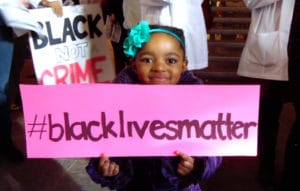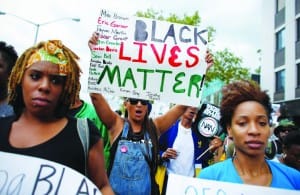by Alicia Garza
July 13 marks two years since Patrisse, Opal and I created #BlackLivesMatter, which began as an online platform designed to connect people online in order to take action together offline. It has since emerged into an international organizing network, with 26 chapters comprised of vibrant, brilliant and innovative Black leaders across generations.
More than a year after creating #BlackLivesMatter, I wrote an article on the Feminist Wire in which I outlined the political vision behind our project.
One point of concern for me at the time was the way in which anti-Blackness is expressed through the retort of “All Lives Matter” and other adaptations. This is still an issue. Two weeks ago, following the murder of nine Black people during a Bible study in Charleston, South Carolina, more than nine Black churches were set ablaze.
White denominations of faith have largely been silent about the deliberate and racist targeting of Black churches, and yet, these same denominations are often the first to proclaim that “All Lives Matter.”
But perhaps more urgently, I argued that if we are serious about transforming this country and our world into one that is led by the fundamental principles of justice and equity, we must be intentional about both acknowledging and fighting for all Black lives.
In the last few months, we’ve seen up close why it is so incredibly important to fight for all Black lives.
If we are serious about transforming this country and our world into one that is led by the fundamental principles of justice and equity, we must be intentional about both acknowledging and fighting for all Black lives.
The ferocity of white supremacy and structural racism rooted in anti-Black ideologies has exposed itself time and time again, to the detriment of our movement.
The world watched as Baltimore erupted over the murder of Freddie Gray, yet was relatively silent about the murder of Mya Hall, a Black trans woman, by the National Security Agency. In McKinney, Texas, 15-year-old Dejerria Becton was flung around like a rag doll in a bikini by police who were called to break up a pool party.
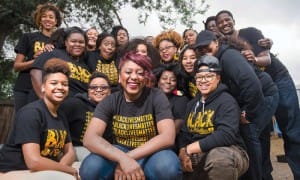
But not more than a week afterwards, the nation’s attention shifted to Rachel Dolezal, a white woman born to a white family who’d been masquerading as a Black woman for more than a decade.
Young women in Ferguson who bravely faced tear gas, rubber bullets and arrest now face assertions that the “gay” movement is attempting to hijack the Black movement, simply because they dare to assert that their lives matter too.
Intersectional politics (and practice) is not just theoretical – it is the lifeline upon which we depend for our collective liberation.
We have succeeded in rallying thousands for the too many Black men who have been killed at the hands of the police, yet the dozens of Black women, cis and trans, who have been killed at the hands of the police get much less attention, garner much less sympathy and even less tangible action to ensure that their lives matter too.
Nine (mostly) Black trans women were killed in the first few weeks of this year, and yet the attention is not there.
Intersectional politics (and practice) is not just theoretical – it is the lifeline upon which we depend for our collective liberation.
Far too many people still see #BlackLivesMatter as a movement that solely addresses the impact of police violence on Black men – yet we have always asserted that this movement, the movement to protect and defend the sanctity of Black lives, has always been about all of us. That Black men must stand beside (and at times behind) Black women, cis and trans, Black queer people, Black poor people, Black immigrants, Black disabled people, Black incarcerated and formerly incarcerated people to fight for all of us, because otherwise none of us are truly free.
The evidence is clear. Trans women of color, including Black trans women, have an average life expectancy of 35 years and are the most impacted by severe unemployment – more than twice the national average. Black women make 64 cents to every 78 cents that a white woman makes to every dollar that a white man makes.
Black women are the fastest growing prison population in this country, mostly for “crimes” of survival. Black girls are the most likely to be suspended from school. A 2012 national study determined that about one half of all people killed by the police each year are mentally ill, and that in the case of local departments, that number jumps to about 75 percent.
Our futures are inextricably intertwined. The #BlackLivesMatter movement has pushed, since 2013, to ensure that all Black lives are seen as an important part of an overall movement for social transformation. We have much to lose if we negate that all Black lives are central to the most well being for all of us.
Our futures are inextricably intertwined. The #BlackLivesMatter movement has pushed, since 2013, to ensure that all Black lives are seen as an important part of an overall movement for social transformation.
We must not rest until all of us are free.
Alicia Garza is special projects director at NDWA (National Domestic Workers Alliance), co-creator of #BlackLivesMatter. She says, “I fall asleep at night dreaming about the infinite possibilities for freedom. Views all mine.” Follow her on Twitter: @aliciagarza. This story first appeared on Those People, which can be reached at stopthosepeople@gmail.com.
This is what the #BlackLivesMatter founders want you to know on the movement’s anniversary
by Jamilah King
On July 13, 2013, George Zimmerman was acquitted of charges relating to the murder of Trayvon Martin. The 17-year-old Martin’s death sparked outraged calls for justice across the country, and in many ways marked the beginning of what has become a modern movement to end the extrajudicial killings of Black people in the United States.
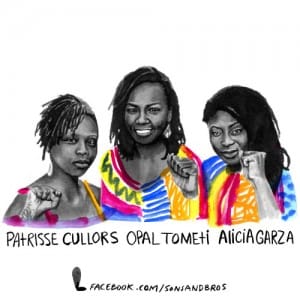
Each of the co-founders sent Mic a statement to mark the anniversary.
Alicia Garza: “For many, birthdays mark joyous occasions. They are celebrations of life, celebrations of another year of growth, lessons learned, obstacles overcome.” She continued, “#BlackLivesMatter rises from the ashes of the Black lives that are taken each and every day by anti-Black racism and state-sanctioned violence.”
Opal Tometi: “I’m grateful that BLM has resonated with people like my family members in Nigeria and allied international networks like the European Network of People of African Descent. International networks like these know that economic globalization and criminalization of Blackness is affecting our people everywhere. In the 21st century, we need our movements to be rigorous about addressing the root causes of these persistent injustices.”
Patrisse Cullors: “All my life I witnessed the horror poor Black folks faced at the hands of the state – from police raids to mothers on welfare, unable to feed their children. I remember feeling like Black folks deserved so much more. We deserve a love that is true and divine. A love that is meant to protect us. On the BLM two-year anniversary, I want #BlackLivesMatter to be a forum for ALL Black lives. I want us to love fiercely and deepen our connectivity. #BlackLivesMatter is more than a slogan; it is a way of life – a new way of life where Black is beautiful, glorious and full of grace.”
Some may balk at the concept of hashtag activism, but these three women coined the phrase to unify a bubbling movement that’s not only existed on social media, but has played out in incredibly powerful moments across the country over the last two years. Here are a handful of the iconic #BlackLivesMatter moments that have led and shaped the current course of Black activism in the United States.
- Protests in Ferguson, Missouri
#BlackLivesMatter gained worldwide attention following the death of Mike Brown, an unarmed 18-year-old who was shot and killed by former Ferguson police officer Darren Wilson.
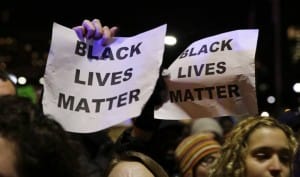
- President Barack Obama pressed to talk about racism
It’s gained so much prominence that even President Barack Obama has taken notice. Earlier this year on The Late Show With David Letterman, the president danced around the phrase “Black lives matter,” saying, “How can we send a message to young people of color and minorities, particularly young men, saying your lives do matter?”
- Oakland, California, demonstrations
During a bold action late last year in Oakland, California, protesters shut down roads near the city’s police headquarters. One scaled a flag pole and put up a sign that remembered Black lives lost to police violence, including 22-year-old Oscar Grant, an unarmed Black man who was shot and killed in Oakland by police in 2009, as portrayed in the 2013 film, “Fruitvale Station.”
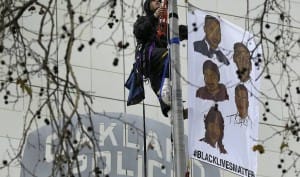
- Athletes take a stand
Some of the world’s most famous athletes began showing support for #BlackLivesMatter. NFL and NBA players wore t-shirts and wrote messages on their shoes, including former NBA MVP Kevin Durant.

- Clinton uses her platform
In a surprise move late last year, current presidential hopeful Hillary Rodham Clinton became the most high-profile American politician to say “Black lives matter.” In April, shortly after she announced her campaign for the presidency, Clinton said the nation needed to face “hard truths about race and justice,” specifically police reform, the disproportionate practice of killing unarmed Black people at the hands of police and mass incarceration.
“Without the mass incarceration that we currently practice, millions fewer people would be in poverty,” she said, according to ThinkProgress. “You cannot talk about smart policing and reforming our justice system without talking about what’s needed to improve economic opportunity, better educational chances for young people, more support to families so they can do the best jobs they are capable of doing to help support their own children.”
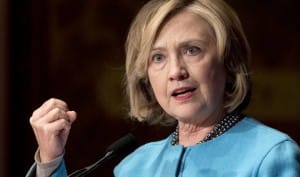
What’s next: In the last two years, Garza writes that the focus on Black lives has been rising, but stories focused on women and LGBTQ people are still excluded in the larger movement – even though the hashtag itself was started by queer women.
“Intersectional politics (and practice) is not just theoretical,” Garza wrote on Medium. “It is the lifeline upon which we depend for our collective liberation.”
Garza’s note, and the collective actions of the last year, reminds us that there’s still plenty of work left to be done. But it’s been quite a ride so far.
Jamilah King is a senior staff writer at Mic, where she focuses on race, gender and sexuality. She was formerly senior editor at Colorlines, an award-winning daily news site dedicated to racial justice. Prior to Colorlines, Jamilah was associate editor of WireTap, an online political magazine for young adults. She’s also a current board member of Women, Action and the Media (WAM!). Her work has appeared on Salon, MSNBC, the American Prospect, Al Jazeera, The Advocate and in the California Sunday Magazine. She’s also a music junkie and an avid Bay Area sports fan. Follow her on Twitter: @JamilahKing. This story first appeared at Mic.com.
Six lessons #BlackLivesMatter can learn from Amilcar Cabral
by Benjamin Woods
“Diplomatic relations can be established with the African Union to, at least, make a statement about the ongoing police violence against Black people in the diaspora.”
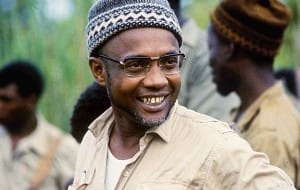
Amilcar Cabral is widely recognized as one of the most creative and influential revolutionary theorists that the African world has ever produced. He was the co-founder and leader of a national liberation movement in West Africa called the African Party for the Independence of Guinea and Cape Verde (PAIGC). Founded in 1956, the PAIGC led an 11 year armed struggle against Portuguese colonialism, culminating in political independence in 1974.
Although an agent of the Portuguese political police assassinated Cabral before political independence was won, his ideas influenced the entire African world including the Black Liberation Movement in the United States. To an extent, his views have been appropriated by various ideological tendencies from Afrocentrists to post-modernists to Marxists.
The objective of this essay is twofold 1) to properly situate Cabral in the tradition of Revolutionary Pan Africanism and Socialism and 2) to demonstrate the lessons he can provide the emergent #BlackLivesMatter Movement.
1) Revolutionary political party. #BlackLivesMatter has inspired and generated numerous mass mobilizations throughout the U.S. The current discussion among organizers concerns how to move from mobilization to organization. Mobilizations are based on mass assemblies and spontaneity, but organization includes continuous political education, a unified political platform and clearly defined long-term objectives.
Cabral chose a political party as the organizational form and #BlackLivesMatter can do the same. A party is composed of cadre or full-time organizers trained in revolutionary ideology who root themselves among the working class. The party must have clear objectives of self-determination and the elimination of the capitalist system.
2) Revolutionary democracy. The PAIGC had two primary components: a) democratic centralism and b) village committees (VC). The objective of democratic centralism is “democracy in discussion, centralism in action.” In his book “Unity and Struggle,” Cabral writes: “It means that each decision concerning a new question must be taken after a full and free discussion within the bodies affected by it or from the base to the top, if the matter is one which affects the whole life of the party. After this discussion and in accordance with what emerges from it, the central bodies take a decision which must immediately be carried out at all levels concerned.”
And at this point, discussion ceases and there is unity in action. This method has been used in successful revolutionary movements in Zimbabwe, Cuba, China, Mozambique, Angola and many more.
The purpose of the VC system was to ensure the democratic participation of the majority of the population. They were responsible along with party cadres for administering social services like education, local defense, health etc. in liberated areas. The VCs were headed by five elected representatives from the local community. To guarantee gender equality two of the elected reps were required to be women.
Even if the VC made a decision that was in contradiction with the party, the VC’s choice was upheld and respected. In the U.S. context, popular assemblies that include a set number of neighborhoods can operate in the same capacity as Village Committees did in Guinea-Bissau. Venezuela’s communal councils and Cooperation Jackson offer excellent contemporary examples.
3) Pan Africanism. Cabral was a staunch supporter of African unity and Pan Africanism. In his own country he was able to organize the PAIGC across ethnic and religious lines. For example, the PAIGC was a secular organization that included Christians, Muslims and traditional religions, but Cabral was agnostic, stating: “I don’t believe there is a life after death.”
He was also a co-founder and spokesperson for the national liberation organizations in Mozambique and Angola. In a speech in 1972 titled “Connecting the Struggles: An Informal talk with Black Americans,” Cabral states: “It is also a contribution for you to never forget that you are Africans.”
The important lesson in this instance is for people of African descent to make practical connections across national borders in their struggles for self-determination. Diplomatic relations can be established with the African Union, currently chaired by the revered Pan Africanist Robert Mugabe, to at least make a statement about the ongoing police violence against Black people in the diaspora.
4) Culture and ideology. Cabral is most often cited for his contributions in explaining the relationship of culture and ideology to social movements and society in general. Unlike some sectors of the American Left that promote a form of economic determinism, Cabral understood that there must be self-conscious effort on the part of the masses and the party to transform the individual and society.
Culture and ideas can be instruments of domination or liberation. Today, individualism, consumerism, American meritocracy and the “illusion of inclusion” are all instruments of social control that must be challenged at the organizational and mass level in order for #BlackLivesMatter to become a broad based social movement.
5) Class suicide. A central component of Cabral’s scientific worldview was the concept of class suicide or a rejection of the values, status and privileges of the dominant society and identification with the working masses. This is especially relevant for the group he called the “petty bourgeoisie” – senior civil servants, intellectuals etc. – who generally are the most indoctrinated into colonial values.
He argued for a “Re-Africanization” which, he asserted, “is only completed during the course of the struggle, through daily contact with the mass of the people and communion of sacrifices which the struggle demands.” He warned against uncritically accepting tradition and cultural determinism.
Cabral understood the new national culture would primarily be built through a process of protracted struggle and have what he called a “mass character.”
6) Scientific socialism. Arguably his most important lesson was in the speech “The Weapon the Theory,” given in 1966 at the Tri-continental Conference in Havana, Cuba. He boldly proclaimed, “Nobody has yet successfully practiced revolution without a revolutionary theory.”
This is extremely relevant today due to the aversion to theory and ideological deficiencies so prevalent in the U.S. Although he didn’t adhere to any particular tendency – Marxism-Leninism, Trotskyism, Maoism etc. – Cabral began his analysis by applying the method of dialectical and historical materialism or scientific socialism to Guinea’s objective socio-economic conditions.
In fact, this is perhaps one of his greatest strengths: his ability to be non-dogmatic and flexible. Similar to Cabral, #BlackLivesMatter should understand that theory emerges from practice and be sure to balance the essential role of political economy and culture.
Cabral claimed that the ultimate objective of the movement was “the liberation of the process of development of the national productive forces – land, labor, tools of production, natural resources.” A master teacher, indeed.
Cabral’s life offers lessons in several other areas such as agronomy, women’s liberation, armed struggle, internationalism, the nature of the state, revolutionary ethics and more. Unfortunately, far too often, he and other Pan-Africanists are reduced to icons or symbols and their actual life and work are sidelined. As the next generation of revolutionary organizers step to the front of the line, it is important we know the contributions and lessons of those who came before us.
A luta continua! (The struggle continues!)
Benjamin Woods is a PhD candidate at Howard University and co-founder of Students Against Mass Incarceration. He can be contacted at benjaminwoods1@yahoo.com or through his website, FreeTheLand. This story first appeared on Black Agenda Report.
Notes:
Cabral, Amilcar (1973) Return to the Source: Selected Speeches by Amilcar Cabral, edited by Africa Information Service, Monthly Review Press, New York, New York.
Cabral, Amilcar (1969) Revolution in Guinea: An African People’s Struggle, Stage 1, London, England.
Cabral, Amilcar (1979) Unity and Struggle: Speeches and Writings of Amilcar Cabral, Monthly Review Press, New York, New York.
Chabal, Patrick (2003) Amilcar Cabral: Revolutionary Leadership and People’s War, Africa World Press, Trenton, New Jersey.
Ed. Firoze Manji and Bill Fletcher (2013), Claim No Easy Victories: The Legacy of Amilcar Cabral, Council for the Development of Social Science Research in Africa.
Gleijeses, Piero (2003) Conflicting Missions: Havana, Washington, and Africa, 1959-1976. Chapel Hill, The University of North Carolina Press.
https://youtu.be/kCghDx5qN4s





